| |
The Insufficient Mating Material Rule
The FIDE Laws of Chess says in article 9.6:
"The game is drawn when a position is reached from which a checkmate cannot occur by any possible series of legal moves, even with the most unskilled play. This immediately ends the game."
This is a very interesting rule, it can determine the result of a game in some situations.
We all know, players agree in draw when they can't mate each other, or often earlier.
This rule says the game is drawn immediately if there is no way to end the game in mate. This is more complex than we think.
In time controlled games it is possible, that if the drawn position is not recognized, one of the players runs out of time and loses the game by time forfeit. Remember, the game is drawn, but the draw is not recognized.
This page is dedicated to summarize which situations are drawn and tries to help how to recognize them. You'll also find examples for all the cases.
See the following list and go through it up to the bottom to check which point matches the current setup.
| Case |
One side |
Other side |
Example |
Result |
| 1. |
King |
King |
A |
Draw |
| 2. |
King + m * Bishops
m > 0
bishops (if more) stand on the same color |
King |
B, C |
Draw |
| 3. |
King + Knight |
King |
D |
Draw |
| 4. |
King + m * Bishops
m > 0
bishops (if more) stand on the same color |
King + n * Bishops
n > 0
bishop (or bishops if more) stand on the same color as bishop or bishops on the other side |
E |
Draw |
| 5. |
Any combination of pieces if there is no way to avoid stalemate |
F, J, K |
Draw |
| 6. |
Any combination of pieces if it is impossible to reach mate, because pieces are blocked and can not be freed, or the free pieces can't mate the opponent's king. |
G, H |
Draw |
| 7. |
Any combination of pieces if there is no way to avoid one of the above situations to happen |
I |
Draw |
| 8. |
In any other cases |
|
Not draw |
Bellow you can find some examples for all the above cases:
| Example A |
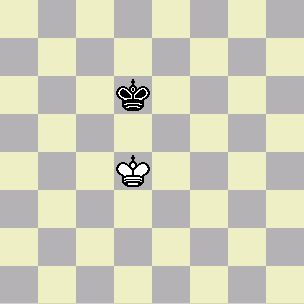
|
This position is clearly drawn, no side can mate the other. |
| Example B |
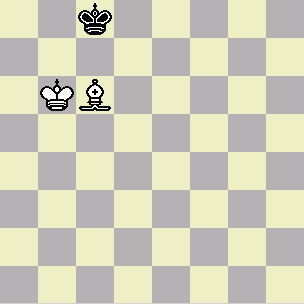
|
This position is also drawn, white can't mate black and black can't mate white. If black's king were in a corner white couldn't control all four squares in that corner with his king and his one bishop, so mate is impossible. Therefore the game is immediately drawn when a position like this occurs. |
| Example C |
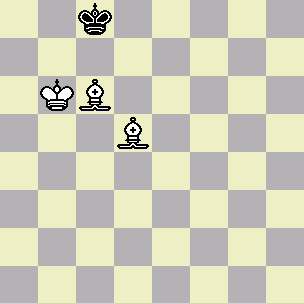
|
This position is also drawn, white can't mate black even with two or more bishops if his bishops move on the same color.
White could win only if he had bishops on different color squares of the board.
Of course this is a strange situation, white has promoted a pawn to a bishop instead of a queen, that would have easily won the game.
|
| Example D |
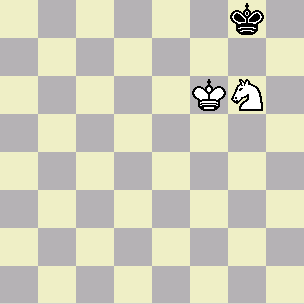
|
This position is also drawn, since white can't control four squares in the corner (or six squares at an edge), so can't mate black. And of course, black can't mate white.
If white had one more knight, the position would not be drawn, because mate is possible with two knights. That is known, mate can't be forced with two knights, but if black plays bad enough, or takes suicide moves (like helpmate) the mate is possible. So a king and two knights against king position is not drawn based on the insufficient material rule.
|
| Example E |
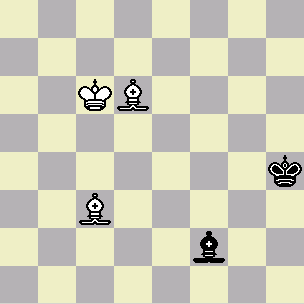
|
This position is drawn, no side can mate the other since all the bishops control the same color squares. The number of bishops doesn't matter if they are all on same color squares of the board. If white could take black's bishops, or black could take white's bishop, the situation would be the same, the game is would remain drawn.
If there were at least one bishop on different color, the game couldn't be terminated in draw, because mate is possible.
|
| Example F |
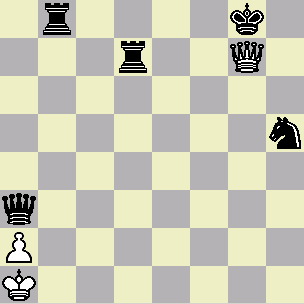
|
Black to move. This setup is drawn, because there is no way to end the game in mate. Black can't avoid white's stalemate, so the game would end in stalemate. White's last move was Qg7+. Black now would have to take the white queen to escape from check either by Kxg7, Rxg7 or Nxg7, and after that the result would be stalemate, so the game can't end in mate. This is why the game is drawn in this position according to the rule at the top of this page.
Anyway this is a good example to show how white can save a half point from a lost position. Black has massive material advantage, and could easily win the game, if white didn't move Qg7+. With this move the game is drawn, regardless how strong black is. |
| Example G |
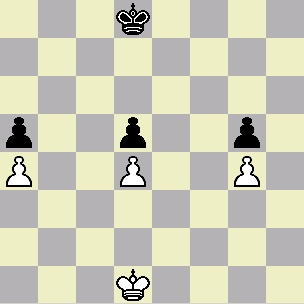
|
This example shows a setup where there is enough mating
material, but mate is still impossible. Both sides are unable to free
their forces, since they can't reach the opponent's pawns. All the
mating pieces are blocked, only the kings could move until the end of
the Time. So the game is drawn immediately when a position like this
occurs.
These positions are the so called dead positions. |
| Example H |
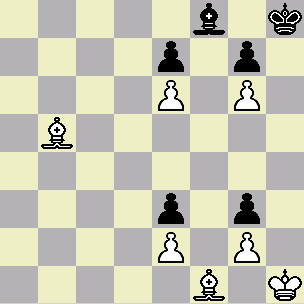
|
This example shows another valid setup, where there are lot of forces, but mate is impossible. This position is not as blocked as the previous, since white has a free bishop. The problem is, that this bishop can't reach black's forces. Mate is impossible, so the game is drawn. |
| Example I |
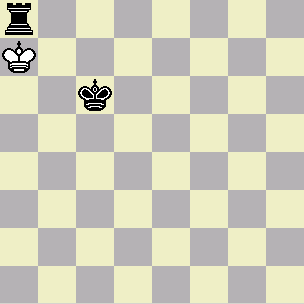 |
White to move. This setup is also drawn immediately according to the rule after black's move. It was Ra8+. White can't move anything else, but capture the black rook by Kxa8. After Kxa8 the setup would be drawn. So, in this position it's impossible to avoid the drawn position. Therefore there is no way to end the game in either side's mate. Therefore the game is drawn right after black's Ra8+. |
| Example J |
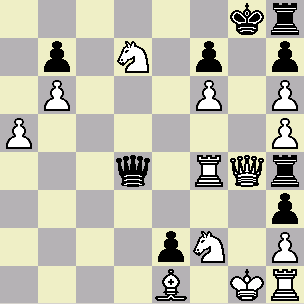
|
Black to move. This is just an example to show how important is to recognize incoming stalemate in time. This position is drawn according to the rule, right after white had moved Qg4+. There is only one move sequence in this position and it leads to stalemate. Therefore the game is drawn, since none of the players can mate each other.
If the game hadn't ended in draw as the rule says, the move sequence would be Rxg4+, Rxg4+, Qxg4+ then Nxg4, when it would be stalemate. It's impossible to avoid stalemate, so the game can't end in mate.
Therefore this position also matches the rule, so the game is immediately drawn after Qg4+.
|
| Example K |
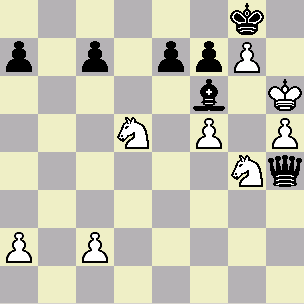
|
If you think these examples are not enough live, then please see this one.
This was the setup between Friedrich Amelung and Helmersen in Tallinn in 1890.
1.Ngxf6+ Qxf6+ (if 1...exf6, the next would be 2.Ne7#)
At this point the game is drawn according to the rule in subject, because the game can not end in either side's win.
Because white has to take the queen: 2.Hxf6+, then black has to take that knight: 2...exf6
Now both kings are blocked, none of them can move, and none of them is attacked. Only the queen side pawns remain, but they will be blocked sooner or later too. Checkmate is not possible.
Thanks for the example to Pal Benyovszki. If you have the whole game, please send it in! |
Some of the above examples are very strange, and probably will never occur in normal life games. But if they still occur, players must see the drawn situation and will agree in draw. At least if everything goes normal. But life is not always logical, nor humans.
In example I it's seemingly no sense to declare draw before white's Kxa8. Why it is good to anybody to declare draw after black's blunder? I'll tell you. See the game before Ra8+. This is a clear black win, no doubt. But black blunders that Ra8+, maybe he wanted to hurry, or else. Suppose, there is no rule that stops the game in this position in draw. In this case, if the game is played over the board, white simply takes that fool rook by Kxa8, and the game is drawn. But if this is a correspondence chess game, white gets a message with that stupid Ra8+, and it's his turn. He has very few time, so he is unable to use up black's blunder in time, he runs out of time. He loses the game by time forfeit. But with this rule, after black plays Ra8+, the game ends in draw immediately, independently if white has very few time left, or not.
In example J there are more moves before the game would end in
stalemate, and if the position is not recognized as drawn, both players
have chance to timeout, which would cause him to lose. Despite the game is drawn according to the insufficient mating material rule, but not
recognized as drawn.
So if a game is declared drawn according to the rule at least one halfmove before a stalemate (example F, I or J) or a dead position, it prevents the players from timeout. And this can change the result of the game.
Written by Andras Galos in Aug 12, 2003, with the essential help of the great people of the rec.games.chess.misc newsgroup.
Any comments are welcome via the Contact page.
|
|
|
| |
Enlace a E4EC
¡Si! Le agradeceremos el poner un enlace a e4ec.org desde su website.
Si lo desea, usted puede utilizar este icono y enlace para crear un enlace gráfico...

http://www.e4ec.org/ajedrez.html
|
| |
|













